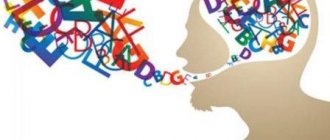In children, speech skills develop gradually until approximately 4 years of age. Some errors in speech are present in children of older preschool age. Over time, with proper communication between the people around them, mistakes in conversation and perception of texts in children disappear.
If a mature person does not understand the written text, can name only a few main words from the information read, does not express his thoughts well, and his speech lacks verbs, prepositions, and conjunctions, he should consult a doctor.
Perhaps the combination of these signs is an expression of a disease called agrammatism. There are several types of deviation. Correct diagnosis can only be made by a qualified doctor after a comprehensive examination.
What underlies the development of the disorder?
A person’s ability to comprehend and reproduce speech depends on a large number of factors:
- age;
- level of general development;
- education;
- communication environment;
- communication skills;
- psychological status;
- physical condition.
The onset of the disease can be triggered by anatomical features, organic changes in local areas of the brain, for example, the Sylvian fissure, the frontal or temporal cortex of the dominant hemisphere.
Normal pronunciation of words and syntactic structures is possible with the impeccable functioning of all nerve cells in the brain.
Total agrammatism in children can also cause impaired hearing during the development of speech. If sound waves are poorly perceived by auditory analyzers, the child hears poorly, and it is difficult, even impossible, for him to formulate sentences correctly.
Speech skills can only be developed through repeated full listening to verbal expressions and immersion in the audio environment of the language.
Emerging speech disorders in adults who already have developed sentence pronunciation skills cannot be explained by changes in the functioning of auditory analyzers. In such situations, there is a high probability of neurological disorders.
Agrammatism is characteristic of the conditions of alalia, aphasia, speech of people without hearing or with poor hearing, and children with developmental delays.
Causes of agrammatism
Parents who observe agrammatism in their child are probably wondering: what are its causes? Several factors can be highlighted here.
The ability to perceive and reproduce speech depends on:
- age;
- education;
- psychological status;
- level of development;
- communication environment;
- physical condition;
- communication skills.
The causes of agrammatism can be:
- Organic changes in a part of the brain.
- Anatomical pathologies.
- Damage to the frontal lobe, Sylvian fissure, temporal lobe.
- Disturbances in the condition of nerve cells in the brain.
Total agrammatism is provoked by underdevelopment or improper functioning of auditory receptors. If they do not correctly or insufficiently pick up sound signals, then it is difficult for the child to understand the speech of others and then reproduce it. Thus, full-fledged speech can be formed when a person hears and perceives surrounding signals well and is immersed in them.
If agrammatism developed in an adult who already has communication skills, then this pathology cannot be explained by a disorder of sound receptors. Doctors associate this with neurological disorders.
Agrammatism is characteristic of people with:
- poor or complete lack of hearing;
- alalia;
- aphasia;
- developmental delay.
Examples of agrammatism
Readers of the medical dictionary slovmed.com will be interested in familiarizing themselves with various examples of agrammatism.
- “Here... surgery... here... emptiness... woke up...”
- “Beautiful girl”, “The cat... was carrying a chicken”, “The girl went home”, “My guests went.”
- “The cat drinks milk” is perceived better than “The cat is running away from the dog.”
- “Ag... Agr... Agra... Agram... Agrammatism.”
- “A girl is going to go for a walk on the street” (“The girl is going to go for a walk on the street”), “The girl is playing with the dog, and the sonic is on the bench” (“The girl is playing with the dog, and the elephant is on the bench”), “The boy is sitting on the bench and needles the balayka” (“A boy sits on a bench and plays a balalaika”).
- “Ride a horsecaf,” not “horses.”
- “A dove sits on a tree” (“A dove sits on a tree”).
Only after diagnosis by a doctor can precise treatment be prescribed. The methods used here are:
- Mechanical.
- Thermal.
- Laser beams.
- Electromagnetic waves.
- Electrical discharge.
- Medicines.
- Implantation of elements.
- Combination of techniques.
Here is a list of methods for preventing and correcting agrammatism:
- Insert missing conjunctions and prepositions into the sentences.
- Pronunciation of words using the “big-small” type.
- Selection of a large number of adjectives and verbs for the word.
- Designation of the spatial location of an object.
- Make up a sentence, change the order of words in the sentence.
go to top
Manifestations of agrammatism
Examples of agrammatisms
It is easier for a person with this disease to understand unambiguous sentences. For example, the phrase “I bought bread” will be understood more easily than the sentence “I am listening to you.” In the second case, unlike the first, the reverse action option “Are you listening to me” is possible.
Short phrases with the classic word order “It’s raining outside” are easier to understand, as opposed to a larger sentence with clarifications “It’s raining incessantly outside again.”
A sick person does not communicate quite competently from a literary point of view. Everyday speech structures differ significantly from correctly constructed sentences. The ability to perceive ordinary speech in people with agrammatism is significantly reduced.
Symptoms can be identified by a specialist through attentive communication, demonstration of visual materials, accompanied by a request to describe them, talk about them. If a person is sick, his speech consists of the simplest sentences, with a minimum of words, often pronounced slowly.
Forms of violation
Experts distinguish two main forms of agrammatism:
- Impressive is characterized by a lack of understanding of speech in whole or in part. The root adjective in the title means “perception” in English. Changes in the functioning of brain cells do not allow the sound signal to transform into thoughts and images.
- Expressive disorders are identified when it is impossible to use prepositions, declensions, and cases in speech; when spoken sentences are formed incorrectly or incompletely. The root of the adjective in this title means "expression" in English. Problems with the functioning of the local area of the brain prevent the transformation of thoughts into speech phrases. Depending on the location of the problem area, the resulting speech anomaly (aphasia) may be sensory or motor in nature.
Sensory changes are caused by a violation of the ability to feel and perceive a sound signal.
Motor disorders in Broca's center cause difficulties in controlling the muscles of the larynx, tongue, and jaws, which do not allow speech to be reproduced well. Often the patient can only pronounce basic words.
His speech resembles the text of a telegraph message, in which nouns predominate or, conversely, only verbs are present. Such specific features make it possible to clarify the localization of the brain area with impaired activity.
Agrammatism symptoms
All symptoms directly depend on the degree of manifestation of the disease, which are manifested in deficiencies in the phonemic structure of speech and vocabulary.
Symptoms of agrammatism manifest themselves in the fact that children begin to speak much later than expected. The emergence of phrasal speech occurs after 2-3, or even 4 years. The speech of children is often filled with agrammatisms, characterized by incorrect use of grammatical forms.
Often parents do not pay attention to disturbances in the child’s speech. They are reassured by the fact that sound pronunciation is normal, which means that over time, they believe, the child will learn to correctly coordinate word combinations. Such a child can successfully master the first grade program, which includes literacy, and also learn the sound structure of words. However, the child faces insurmountable difficulties in mastering the morphological principles of writing. And only after this, in a state of bewilderment, do parents turn to specialists (speech therapist, neurologist). The teacher actually immediately discovers that the child is unable to learn the rules for declension of words by gender, case, and number. This is noted in the incorrect agreement of words, as well as the spelling of word endings. The student writes ungrammatically (contrary to the rules of grammar). For example, “long tape”, “on the window”.
According to age-related skills, a child should be able to coordinate words correctly by the age of 4. And by this age, errors in speech are not the norm. If your child makes mistakes like “near the table” or “trees”, you need to get advice from specialists.
As for the rules of word formation using prefixes and suffixes, the child masters these skills much later, by the age of 7-8. At the age of 7-8 years, a student must agree words with each other, as well as form new words. If this does not happen, then agrammatism in children is diagnosed.
Agrammatisms in schoolchildren are detected immediately upon admission to an educational institution. Children have pronunciation defects, unformed lexical and grammatical structure, phonemic perception, and coherent speech.
Agrammatisms in children aged 7-8 years appear most clearly. It is during this period that children already master literacy and also begin to learn grammatical rules. The prerequisites for this are poor vocabulary. And as research shows, it is precisely because of the poverty of the vocabulary, as well as inaccuracies in understanding the lexical meaning of words, that this violation occurs.
Establishing diagnosis
Correct diagnosis is the result of comprehensive observation and examination. It is very important to determine:
- general condition of a person,
- his psychological and neurological status.
During communication, the specialist evaluates:
- rate of speech;
- variety of syntactic forms used;
- correct use of cases and declensions in speech;
- the presence of unions;
- the presence of prepositions in dialogue and monologue when describing a visual object.
When testing, the number of words and syllables in spoken sentences and the consistency of the endings used are assessed.
To identify disorders of brain activity, it is recommended to do an encephalogram, ultrasound or tomography.
Summarizing and analyzing the information received, the specialist makes a decision to establish a diagnosis.
Treatment methods
Agrammatism is a neurological disorder that requires the help of qualified specialized doctors. Medical treatment, depending on the age and severity of the patient’s condition, may include a course of medication, reflexology, physiotherapeutic procedures, and hypnosis.
Correcting the condition with medications can significantly improve the blood circulation of brain cells and make them function more efficiently.
Impact on active points during reflexology can be carried out using different methods:
- mechanically;
- thermally;
- electrical discharge;
- laser beams;
- electromagnetic waves;
- pharmaceuticals;
- implantation of foreign elements;
- combining techniques.
Author's techniques, tested by many years of experience? differ in the choice of sensitive points on the patient’s body and methods of acting on them.
Positive changes are observed during physiotherapy for expressive agrammatism. For sensory problems, the correct choice of physiotherapeutic methods helps to improve the patient’s perception of sounds.
The influence of motor anomalies is minimized by restoring the activity of the muscles of the larynx, jaw, and tongue.
Agrammatism, like other neuropsychological disorders, can be corrected by professional hypnosis, which improves the quality of spoken speech.
The treatment algorithm is selected by specialists individually. In addition to medical care, the patient will need the help of psychologists, speech therapists, and teachers during the recovery period.
How to treat agrammatism, how to cure agrammatism, how to get rid of agrammatism in Sarklinik?
Sarklinik knows how to treat agrammatism , how to restore the grammatical structure of speech, how to get rid of agrammatism in Saratov. New reflexology treatment methods have helped many of our patients get rid of agrammatism. Effective treatment gives excellent results; patients (children and adults) restore the ability to use the grammatical structure of speech. On our website sarclinic.ru you can see a doctor for free and get a short answer on the treatment of agrammatism.
Sign up for a consultation. There are contraindications. Specialist consultation is required.
Photo: Bds | Dreamstime.com\Dreamstock.ru. The people depicted in the photo are models, do not suffer from the diseases described and/or all similarities are excluded.
Related posts:
Perinatal encephalopathy, consequences, treatment
Encopresis in children, neurotic encopresis, treatment of encopresis
Akatagraphy, treatment of akatagraphy
Yactation, rocking, nodding movements of the head, torso, body
Neuropathy, childhood nervousness, treatment, nervous child
Comments ()
You can anticipate trouble
To prevent the appearance of agrammatism, the normal neonatal period of the child’s formation is very important.
Neurological disorders of the unborn child can develop during a difficult pregnancy, aggravated by infectious or other diseases. A correct lifestyle and regular observation by an attentive doctor of the expectant mother is the key to the birth of a healthy baby.
Abnormalities in the functioning of brain cells can appear in adults due to past illnesses and circulatory disorders. A preventive measure is a careful attitude to one’s own state of health, the use of general strengthening procedures in everyday practice, and the formation of healthy lifestyle habits.
The condition of patients with agrammatism can be significantly improved, up to complete recovery. Successful treatment is possible with timely consultation with specialists and strict adherence to the doctor’s recommendations.









